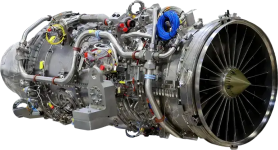TS1400 is a 1400HP class turboshaft engine. Hence its specified safe continuous power delivery will be below 1400HP. But it’s safe 5 minute take off maximum power level will be around or may be slightly more than 1400HP.
These engines are subjected to extreme power demands during take off and in emergency landing situations whereby a single engine operation may be required. Therefore it is a necessary requirement that they should be able to deliver a great deal more power to help achieve safe landing on demand.
Below is the FAA paper on the subject of OEI 30 second and 2 minute max power operational condition.
Our TS1400 is already developing some 10% more continuous power than the LHTEC engine it is replacing which has a specified continuous take off power delivery of 1373HP.
But it has to be remembered that as an inherent situation with this size of radial flow turboshaft engine performance, the number of compressor stages are limited to two, and the output power delivery is thus limited. Continuous power delivery of these engines will not exceed around 1500HP.
Below is the table of LHTEC-CTS800-4N engine specified as a 1363HP maximum take off power engine and EASA certification test data sheet where the OEI and other power levels are given as :
OEI 30 sec. : 1620HP
OEI 2 min : 1486 HP
Continuous OIE : 1360 HP
Take-off 5 min : 1360 HP
Max continuous : 1281 HP
It is the same case where TEI is building under licence the T700 Blackhawk engines.
These engines are classified as 2000HP engines. But they continuously deliver 1716HP. Yet they have continuous max take off power of 1994HP.
Would be great if TEI decides to develop a 3000HP engine. But resources are limited, I guess. Turkey needs to be completely independent engines wise. It is one of our key weaknesses.











